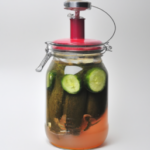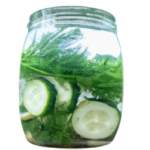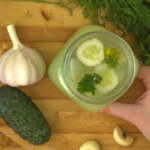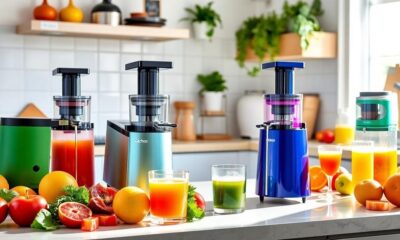Juice Tips and Tricks
How To Make Pepperoncini Juice
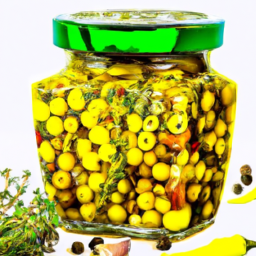
Pepperoncini peppers are a key ingredient in many dishes, offering a tangy and slightly spicy taste. Were you aware that you can also make juice from these delicious peppers?
That’s right, pepperoncini juice can be a delicious addition to marinades, dressings, and even cocktails. In this article, I’ll share with you my simple and easy recipe for making homemade pepperoncini juice.
Gathering your ingredients is the first step to making this tangy juice. You’ll need fresh pepperoncini peppers, water, and vinegar. I recommend using distilled white vinegar for its neutral taste. Once you have your ingredients, wash the pepperoncini peppers thoroughly to remove any dirt or residue. After cleaning, you’ll combine the water and vinegar in the right proportions to ensure a balanced yet tangy flavor. If you’re curious about how to extract olive juice, note that it’s typically drawn from the pressing or maceration of olives, but it’s not needed for this particular recipe.
With just a few simple steps, you’ll have a jar of homemade pepperoncini juice that’s perfect for adding a burst of flavor to any dish. So, let’s get started!
Key Takeaways
- Boil water and simmer fresh pepperoncini peppers for 10 minutes to release flavor compounds.
- Strain peppers and add vinegar for preservation and enhanced flavor.
- Blend mixture for a smooth and consistent texture.
- Store in a clean, airtight container in the refrigerator for up to a week or freeze for long-term storage.
Gather Your Ingredients
Now, let’s gather all the ingredients we need to make this delicious pepperoncini juice! For this recipe, you’ll need fresh pepperoncini peppers, water, salt, and vinegar.
You can find pepperoncini peppers at most grocery stores or farmers’ markets. Make sure to choose peppers that are bright green, firm, and free from any blemishes or bruises.
Pepperoncini juice is not only tasty, but it also offers numerous health benefits. It’s high in antioxidants and vitamin C, which can boost your immune system and improve your overall health. Additionally, the juice can aid in digestion and reduce inflammation in the body.
With so many uses for pepperoncini juice, it’s definitely worth trying out this recipe. Now, let’s move onto the next step and wash and slice the pepperoncini peppers.
Wash and Slice the Pepperoncini Peppers
First, grab a handful of fresh pepperoncini peppers and rinse them thoroughly under cold water to remove any dirt or debris. The pepperoncini pepper is a type of chili pepper that’s often pickled and used as a condiment. Aside from being a great addition to sandwiches and salads, pepperoncini peppers are also packed with health benefits. They’re rich in vitamins A and C, as well as minerals like calcium and potassium. Additionally, they contain capsaicin, a compound that’s been shown to have anti-inflammatory properties.
After washing the peppers, slice them into small pieces using a sharp knife. The slices should be thin enough to release the pepperoncini juice easily. There are different ways to use pepperoncini slices, but for this recipe, we’ll be using them to flavor the water.
So, once the pepperoncini peppers are sliced, we can move on to the next step of boiling the water.
Boil the Water
To get started, simply bring a pot of water to a boil. Boiling water is a fundamental step in many recipes, but it’s not as simple as just turning on the stove.
To properly boil water, fill your pot with enough water to cover the peppers, and then place it on the stove over high heat. Cover the pot with a lid to help it boil more quickly, and keep an eye on it to make sure it doesn’t boil over.
When boiling water, it’s important to use a pot that’s large enough for the amount of water you’re boiling. This prevents the water from boiling over and making a mess on your stove. Additionally, make sure to use clean, fresh water to prevent any unwanted flavors from seeping into your dish.
Once the water is boiling, remove the lid and add the sliced pepperoncini peppers to the pot.
Add the Sliced Pepperoncini Peppers to the Boiling Water
You’ll want to add those sliced peppers to your boiling water as soon as it’s ready, so they can infuse your dish with their tangy flavor. Once the water is boiling, carefully drop the sliced pepperoncini peppers into it and let them cook for a few minutes. As they cook, the water will start to turn a vibrant yellow-green color, and the aroma of the peppers will fill the air.
Using pepperoncini juice in recipes can add a unique and zesty flavor to your dishes. It’s not only delicious, but also has some health benefits. Drinking pepperoncini juice can help aid digestion, boost the immune system, and reduce inflammation. So, let those sliced peppers simmer in the boiling water for about 10 minutes, while you prepare the rest of your dish and enjoy the benefits of using pepperoncini juice in your cooking.
Let the Peppers Simmer for 10 Minutes
As the peppers simmer for 10 minutes, you’ll notice the water turning a vibrant yellow-green color and the aroma filling the air, all while enjoying the health benefits that come with this zesty addition to your dish.
Simmering techniques are key to unlocking the full flavor potential of pepperoncini peppers. The process allows the peppers to release their essential oils and flavor compounds, resulting in a rich and tangy juice that pairs perfectly with a variety of dishes.
But the benefits of this simmering process go beyond just taste. Did you know that studies have shown that consuming spicy foods like pepperoncini can actually boost your metabolism, helping you burn calories more efficiently?
Additionally, pepperoncini peppers are a great source of vitamin C and antioxidants, which can help boost your immune system and protect against chronic disease. So not only is this juice delicious, it’s also good for you.
As the peppers continue to simmer, it’s time to prepare for the next step: straining the peppers to extract the juice.
Strain the Peppers
Once the peppers have simmered for 10 minutes, it’s time to strain them and extract the flavorful liquid. I like to use a fine mesh strainer to remove any seeds or skin that may have come loose during the simmering process. Once the liquid has been strained, you can discard the remaining pepper solids or save them for another use.
It’s important to note that pepperoncini juice is not only delicious, but it also has some impressive health benefits. According to some studies, the antioxidants found in peppers may help to reduce inflammation and improve heart health. Additionally, the juice may also have antibacterial properties that can aid in digestion and boost the immune system. To preserve these benefits, it’s best to store the juice in an airtight container in the refrigerator for up to two weeks. With the pepperoncini juice strained and ready, it’s time to add the vinegar to create a tangy and flavorful concoction that can be used in a variety of ways.
Add the Vinegar
Now it’s time to give your tangy creation a kick by pouring in the vinegar. This will infuse the pepper-infused liquid with a punchy acidity that’ll make your taste buds dance with delight. You can choose from a variety of alternative vinegars to add a unique twist to your pepperoncini juice. For example, balsamic vinegar can add a touch of sweetness, while apple cider vinegar can add a fruity flavor. Red wine vinegar can also be used to give your juice a delicious tang.
Benefits of adding vinegar to your pepperoncini juice include not only enhancing the flavor, but also preserving the juice for a longer shelf life. Vinegar is a natural preservative that inhibits the growth of bacteria and mold, keeping your juice fresh for weeks. Additionally, vinegar is known to have health benefits such as aiding in digestion and reducing inflammation in the body. So not only will your pepperoncini juice taste great, but it’ll also be good for you!
With the vinegar added, it’s time to blend the mixture for a smooth and consistent texture.
Blend the Mixture
Imagine the whirring of the blender as you combine the fiery peppers, garlic, and tangy vinegar into a harmonious blend that’ll awaken your taste buds and leave you craving more.
When blending the pepperoncini juice, it’s important to consider the options of the blender and the mixing techniques that’ll yield the best results. Blender options will vary depending on personal preference and budget. Some may prefer a high-powered blender for a smoother consistency, while others may choose a hand blender for more control over the texture. Mixing techniques such as pulsing or continuous blending can also have an impact on the final product. Experiment with different combinations to find the perfect blend for your taste.
With the blending process complete, it’s time to move on to the next step of storing the pepperoncini juice.
Store the Pepperoncini Juice
To keep your taste buds dancing, you’ll want to store this tangy blend properly. Pepperoncini juice can be stored in a few different ways, depending on how long you want it to last and what you plan to use it for. Here are some preservation methods and creative uses to consider:
-
Refrigeration: The easiest way to store your pepperoncini juice is to transfer it to a clean, airtight container and keep it in the refrigerator. This will keep the juice fresh for up to a week, although it may start to lose its flavor and potency over time.
-
Freezing: If you have a lot of pepperoncini juice and want to save it for later, you can freeze it in ice cube trays or small containers. This will preserve the juice for several months and allow you to use it in recipes or as a condiment whenever you need it.
-
Canning: For a longer-term storage option, consider canning your pepperoncini juice using a hot water bath. This will sterilize the juice and keep it safe to use for up to a year or more. Just be sure to follow proper canning procedures to prevent spoilage or contamination.
-
Creative uses: Pepperoncini juice is a versatile ingredient that can be used in a variety of ways. Try using it as a marinade for meats, a dressing for salads, a dip for vegetables, or a flavor enhancer for soups and stews.
Now that you know how to store your pepperoncini juice, it’s time to enjoy it! In the next section, I’ll share some tips and ideas for using your homemade juice to add flavor and spice to your favorite dishes.
Enjoy Your Homemade Pepperoncini Juice!
You’re ready to savor the tangy and versatile flavor of your homemade pepperoncini juice! Now that you’ve successfully made your own batch of pepperoncini juice, there are a number of creative uses and health benefits to explore.
One of my favorite ways to enjoy pepperoncini juice is by using it as a marinade for meats or vegetables. The acidity of the juice helps to tenderize the food while infusing it with a delicious tangy flavor.
You can also use it as a dressing for salads or as a topping for sandwiches and burgers to add a little kick. And don’t forget about using it as a key ingredient in your favorite sauces or dips for added depth of flavor.
In addition to its culinary uses, pepperoncini juice also has a number of health benefits. It has been shown to aid in digestion and boost metabolism, making it a great addition to your diet. It also contains antioxidants and anti-inflammatory properties, which can help to reduce inflammation and promote overall wellness.
So not only is your homemade pepperoncini juice tasty, it’s also good for you!
Frequently Asked Questions
What are some common uses for pepperoncini juice?
I love using pepperoncini juice in my cooking. It adds tanginess and a subtle kick to salads, sandwiches, and even marinades. Some of its benefits include aiding digestion and boosting the immune system.
How long can you store homemade pepperoncini juice in the fridge?
I once made a batch of homemade pepperoncini juice and stored it in the fridge for up to two months. The key to extending the shelf life is to keep it in an airtight container and check for any signs of spoilage.
Can you use other types of vinegar besides white vinegar in the recipe?
Yes, you can use different types of vinegar besides white vinegar in pepperoncini juice. Apple cider vinegar or rice vinegar can add unique flavor variations. Experiment with different vinegars to find your preferred taste.
What are some variations or additions you can make to the basic recipe?
Cooking is like painting. You can start with a blank canvas and add various colors and textures to create a masterpiece. Flavorful variations of pepperoncini juice may include adding garlic, honey, or using apple cider vinegar. Ingredient substitutions could be using jalapeños or banana peppers.
How spicy is the final product? Is there a way to adjust the heat level?
To adjust spiciness, add or reduce the amount of pepperoncinis used. Flavor variations can also be achieved by adding garlic, oregano, or lemon juice. The final product can range from mild to hot depending on preference.
Conclusion
I’m so excited to have made my own pepperoncini juice! Gathering the ingredients was easy, and slicing the peppers was a breeze. Boiling the water was simple, and adding the sliced pepperoncini peppers was a snap.
Letting the peppers simmer for 10 minutes was a cinch, and adding the vinegar was a breeze. Blending the mixture was quick and easy, and storing the pepperoncini juice was a no-brainer.
Now, I can enjoy my homemade pepperoncini juice anytime I want! This recipe is so simple and easy to follow, and the end result is truly delicious. I can’t wait to try it with different dishes and see how it enhances the flavors.
Give it a try yourself and enjoy the taste of homemade pepperoncini juice!
Susannah expertise lies in researching and compiling evidence-based content on juicing, nutrition, and overall health. She is committed to ensuring that The Juicery World offers accurate, up-to-date, and trustworthy information to empower readers to take control of their health. Susannah’s goal is to inspire individuals to embrace juicing as a way to nourish their bodies and live their best lives.
Juice Tips and Tricks
How to Make Aloe Vera Juice Taste Better

Tired of the strong flavor of aloe vera juice? No problem, we’ve got the answer for you.
In this article, we’ll share some tips and tricks to make your aloe vera juice taste better. We have tried and tested various methods to enhance the flavor without compromising the health benefits.
From choosing the right juice to adding natural sweeteners and infusing with fruits and herbs, we’ve got all the information you need to transform your aloe vera juice into a delightful and refreshing beverage.
Let’s dive in!
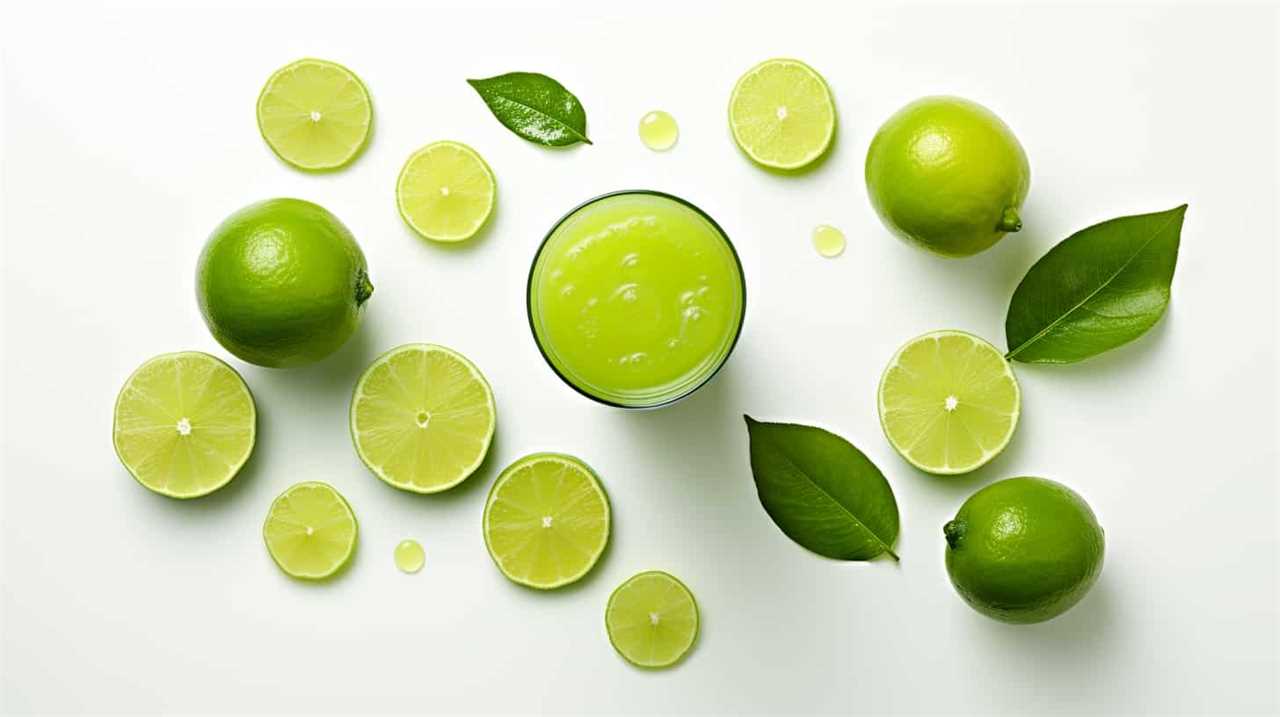
Key Takeaways
- Choose a reputable brand of aloe vera juice that prioritizes quality and uses organic, pure aloe vera.
- Avoid brands that contain added sugars or artificial ingredients.
- Use natural sweeteners like honey, agave syrup, or stevia to enhance the taste of aloe vera juice.
- Experiment with adding fruits, herbs, and other juices to create unique flavor combinations and enhance the health benefits of aloe vera juice.
Choosing the Right Aloe Vera Juice
We can enhance our experience with aloe vera juice by selecting the right brand and type for our preferences. When it comes to finding a reputable brand, it’s important to do some research and read reviews from other consumers. Look for brands that prioritize quality and use organic, pure aloe vera without any added sugars or artificial ingredients. Understanding the health benefits of aloe vera juice is also crucial in making the right choice. Aloe vera is known for its soothing properties, aiding digestion, promoting skin health, and boosting the immune system. By choosing a high-quality brand, we can ensure that we’re getting the maximum benefits from our aloe vera juice.
Now that we know how to choose the right brand, let’s move on to the next step of adding natural sweeteners.
Adding Natural Sweeteners
To enhance the flavor of our aloe vera juice, we can add natural sweeteners such as honey or agave syrup. Using alternative sweeteners not only adds sweetness but also brings unique flavors to the juice. Here are some options to consider:
- Stevia: A natural sweetener derived from the Stevia plant, it’s a zero-calorie alternative to sugar.
- Maple Syrup: This natural sweetener adds a rich and earthy flavor to the aloe vera juice.
- Dates: Pureed dates can be used to sweeten the juice while also providing essential nutrients like fiber.
In addition to using alternative sweeteners, we can enhance the flavor of aloe vera juice by adding spices and extracts. Cinnamon, ginger, or vanilla extract can add warmth and depth to the taste. By experimenting with different combinations of these natural sweeteners, spices, and extracts, we can create a flavor profile that suits our preferences.
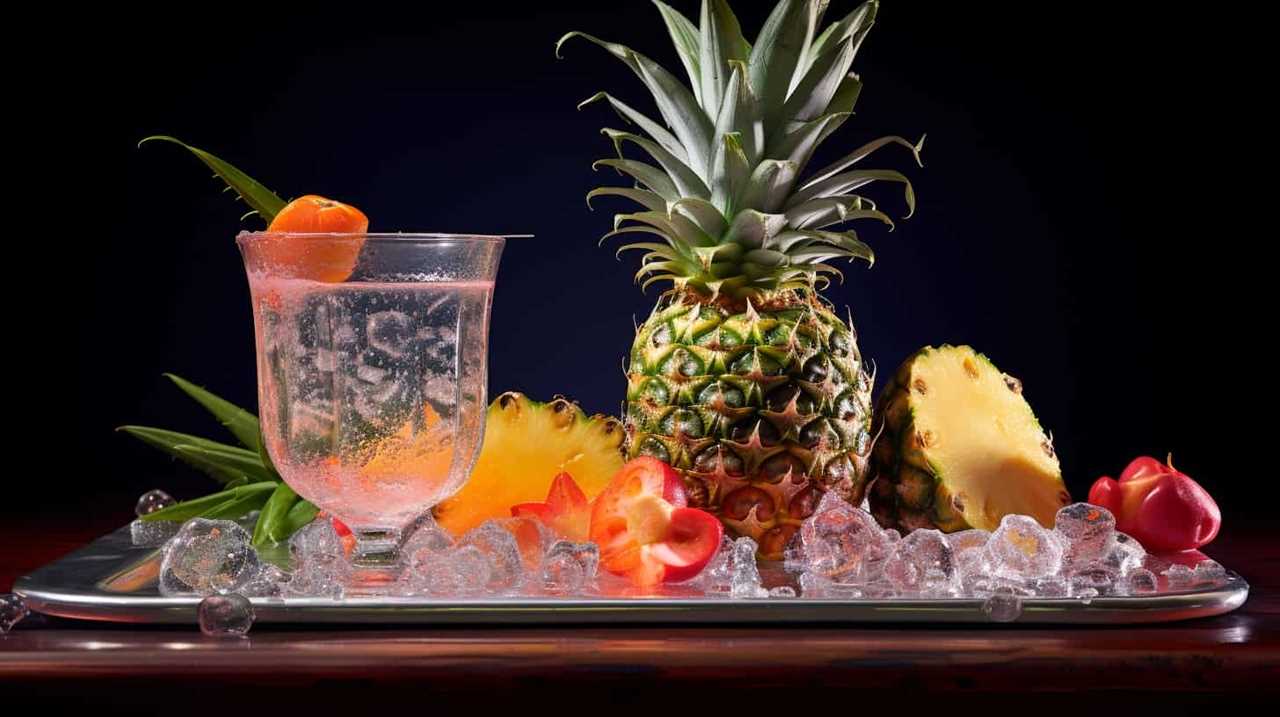
Now, let’s move on to the next section and learn how to infuse aloe vera juice with fruits and herbs to further enhance its taste.
Infusing With Fruits and Herbs
As we explore ways to make our aloe vera juice taste better, one option to consider is infusing it with fruits and herbs. Creating unique aloe vera blends by adding fruits and herbs not only enhances the flavor but also adds a touch of freshness and complexity to the juice. For example, combining aloe vera juice with lemon, mint, or berries can create a refreshing drink that’s both delicious and packed with additional nutrients. It’s similar to the ease of making lemonade with bottled juice—quick, convenient, and customizable to suit your preferences. By experimenting with different fruit and herb combinations, you can elevate your aloe vera juice experience while still reaping its health benefits.
Fruits like strawberries, pineapple, or citrus can add a burst of sweetness, while herbs like mint, basil, or ginger can provide a subtle yet refreshing twist. Exploring the benefits of herbal infusions can also be beneficial for our health. For example, adding a few sprigs of lavender can promote relaxation and reduce stress. Additionally, infusing aloe vera juice with rosemary can aid digestion and boost the immune system.
Blending With Other Juices
Let’s try mixing aloe vera juice with different fruit juices to create delicious and refreshing blends. Blending aloe vera juice with other fruits not only enhances its taste but also adds nutritional benefits to your drink. Here are three fruit juices that you can mix with aloe vera juice:

- Orange juice: Combining aloe vera juice with orange juice not only adds a tangy flavor but also boosts your intake of vitamin C, which is essential for a strong immune system.
- Pineapple juice: Mixing aloe vera juice with pineapple juice creates a tropical blend that isn’t only refreshing but also helps in digestion. Pineapple contains bromelain, an enzyme that aids in breaking down proteins and promoting better digestion.
- Watermelon juice: Blending aloe vera juice with watermelon juice creates a hydrating and refreshing combination. Watermelon is rich in water content and contains electrolytes that can help replenish your body’s fluids.
Experimenting With Flavor Combinations
While we can try various flavor combinations with aloe vera juice, it’s important to find the right balance to enhance its taste. Experimenting with different flavors can’t only make the juice more enjoyable but also enhance its health benefits.
Aloe vera juice is known for its numerous health benefits, such as boosting digestion, promoting hydration, and supporting the immune system. By adding complementary flavors, we can create a refreshing summer drink that not only tastes great but also provides a nutritional boost.
Some popular flavor combinations include mixing aloe vera juice with citrus fruits like lemon or orange, adding a splash of coconut water for a tropical twist, or combining it with cucumber and mint for a refreshing and cooling effect.
Don’t be afraid to get creative and find the flavor combination that suits your taste buds best!

Frequently Asked Questions
Can I Use Store-Bought Aloe Vera Gel Instead of Fresh Aloe Vera for Making Juice?
Yes, you can use store-bought aloe vera gel instead of fresh aloe vera for making juice. However, it’s important to note that fresh aloe vera juice may have more health benefits due to its higher nutrient content.
How Long Can I Store Aloe Vera Juice in the Refrigerator?
Aloe vera juice can be stored in the refrigerator for up to a week. Refrigeration helps maintain the longevity and freshness of the juice, preserving its beneficial properties. It’s important to store the juice in an airtight container to prevent contamination and maintain its quality. Similarly, you might wonder *how long ginger juice lasts*; typically, fresh ginger juice can be refrigerated for about 1–2 weeks as well. Both aloe vera and ginger juices are best consumed within their shelf life to ensure maximum potency and health benefits. Additionally, freezing either juice can extend their shelf life, though some loss of nutrients and potency may occur during the process. When thinking about *how long fresh juice lasts*, it’s crucial to check for signs of spoilage, such as changes in smell, taste, or color, before consuming. To enjoy the best results, it’s always recommended to use fresh ingredients and properly store the juice to ensure you’re getting the most out of its health benefits.
Can Aloe Vera Juice Help With Digestive Issues?
Aloe vera juice can potentially help with digestive issues when taken in appropriate dosages. However, it is important to note that there may be potential side effects. It is always best to consult with a healthcare professional before starting any new supplement regimen.
Can I Use Artificial Sweeteners Instead of Natural Sweeteners in My Aloe Vera Juice?
Using artificial sweeteners in aloe vera juice may affect its taste and potential health benefits. However, natural sweeteners like honey or stevia can enhance the flavor without compromising its nutritional value.

Is It Safe to Drink Aloe Vera Juice Every Day?
Drinking aloe vera juice daily can have numerous benefits, such as improving digestion and boosting the immune system. However, consuming it regularly may also lead to potential side effects like diarrhea or stomach cramps.
Conclusion
In conclusion, making aloe vera juice taste better is easy and enjoyable.
By choosing the right aloe vera juice and adding natural sweeteners, infusing with fruits and herbs, blending with other juices, and experimenting with flavor combinations, you can create a delightful and refreshing drink.
So go ahead and unleash your creativity in the kitchen, and transform your aloe vera juice into a sensational elixir that will transport your taste buds to paradise.
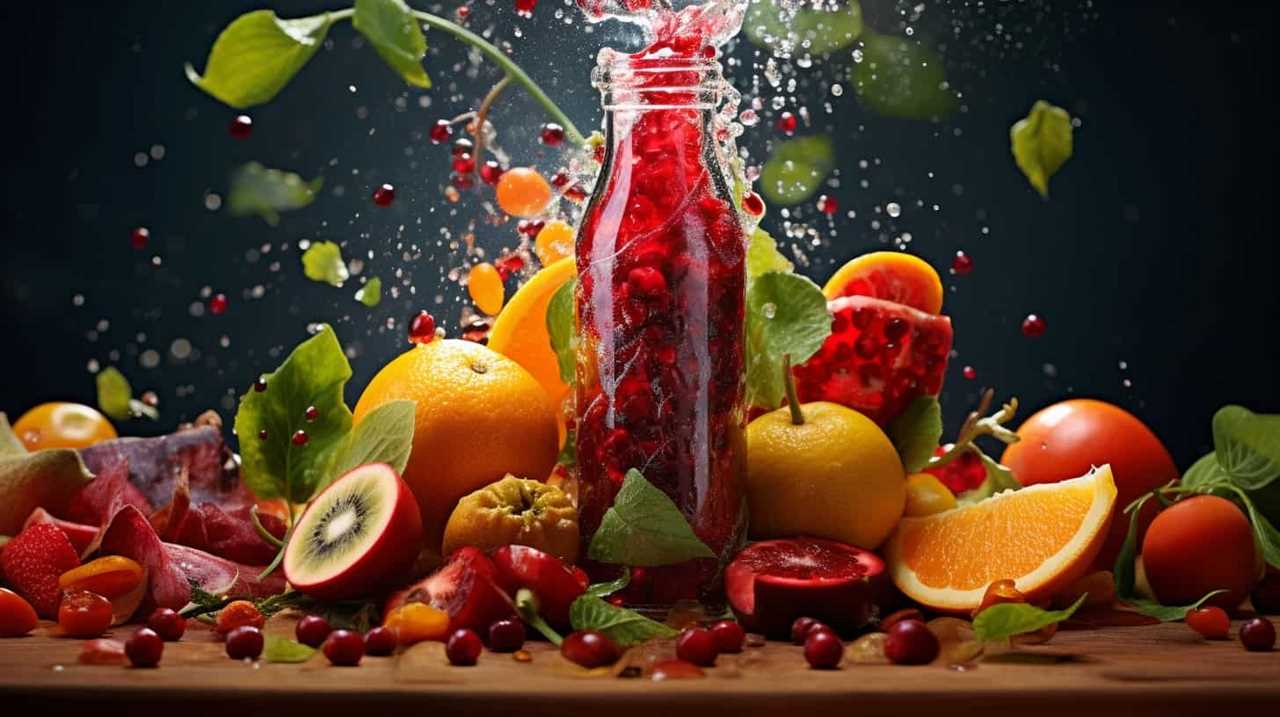
Susannah expertise lies in researching and compiling evidence-based content on juicing, nutrition, and overall health. She is committed to ensuring that The Juicery World offers accurate, up-to-date, and trustworthy information to empower readers to take control of their health. Susannah’s goal is to inspire individuals to embrace juicing as a way to nourish their bodies and live their best lives.
Juice Tips and Tricks
How to Make a Glass of Lemonade With Bottled Lemon Juice

Are you craving a cool glass of lemonade to quench your thirst? Look no further! Try out our perfect recipe using bottled lemon juice that will surely please your taste buds.
In this article, we’ll guide you through the process of creating a tangy and sweet concoction that will leave you feeling refreshed and satisfied.
So grab your ingredients and let’s get started on this delightful journey of serving ourselves and others a glass of pure lemony goodness.
Key Takeaways
- Consider the storage of the bottled lemon juice (dark glass or plastic bottles, protect from light exposure, check expiration date)
- Choose a suitable pitcher and fresh lemons for enhanced flavor
- Store the lemonade concentrate in the refrigerator to maintain freshness
- Adjust the sweetness and tartness to taste with sugar or more lemon juice, and experiment with different sweeteners or additional flavors.
Choosing the Right Bottled Lemon Juice
What are the key factors we should consider when selecting the right bottled lemon juice for our lemonade?

One important factor is how the lemon juice is stored. Look for bottles that are made of dark glass or plastic, as they help protect the juice from light exposure, which can degrade its quality. It’s also important to check the expiration date to ensure freshness.
Another benefit of using bottled lemon juice is convenience. It saves time and effort compared to squeezing fresh lemons. Additionally, bottled lemon juice provides consistent flavor, as the acidity levels are standardized.
When selecting a brand, consider reading reviews and checking for certifications, such as organic or non-GMO.
Gathering the Necessary Ingredients and Tools
How can we gather all the necessary ingredients and tools to make a glass of lemonade with bottled lemon juice? First, we’ll need to collect bottled lemon juice, sugar, and cold water, as well as a pitcher and a spoon for mixing. If you prefer extra flavor, you can also gather ice and optional add-ins like mint or soda water. While preparing the lemonade, it’s easy to understand why some people wonder about other citrus drinks and may ask, “how many oranges per gallon” are needed when making orange juice instead. Once everything is assembled, combine the lemon juice, sugar, and water in the pitcher, stirring until the sugar dissolves. Feel free to adjust the sweetness or tartness to your liking, and don’t forget to add ice or any optional add-ins for an extra refreshing touch. This process might even make you curious about how much juice from oranges is needed when making fresh orange juice compared to using bottled citrus products. Once your lemonade is ready, pour it into a glass and enjoy the refreshing taste. This simple recipe can inspire you to try other homemade juices, such as learning **how to make pear juice** or experimenting with other fruit combinations. Whether you’re using fresh fruits or bottled options, creating your own beverages is a fun and rewarding way to personalize your drinks.
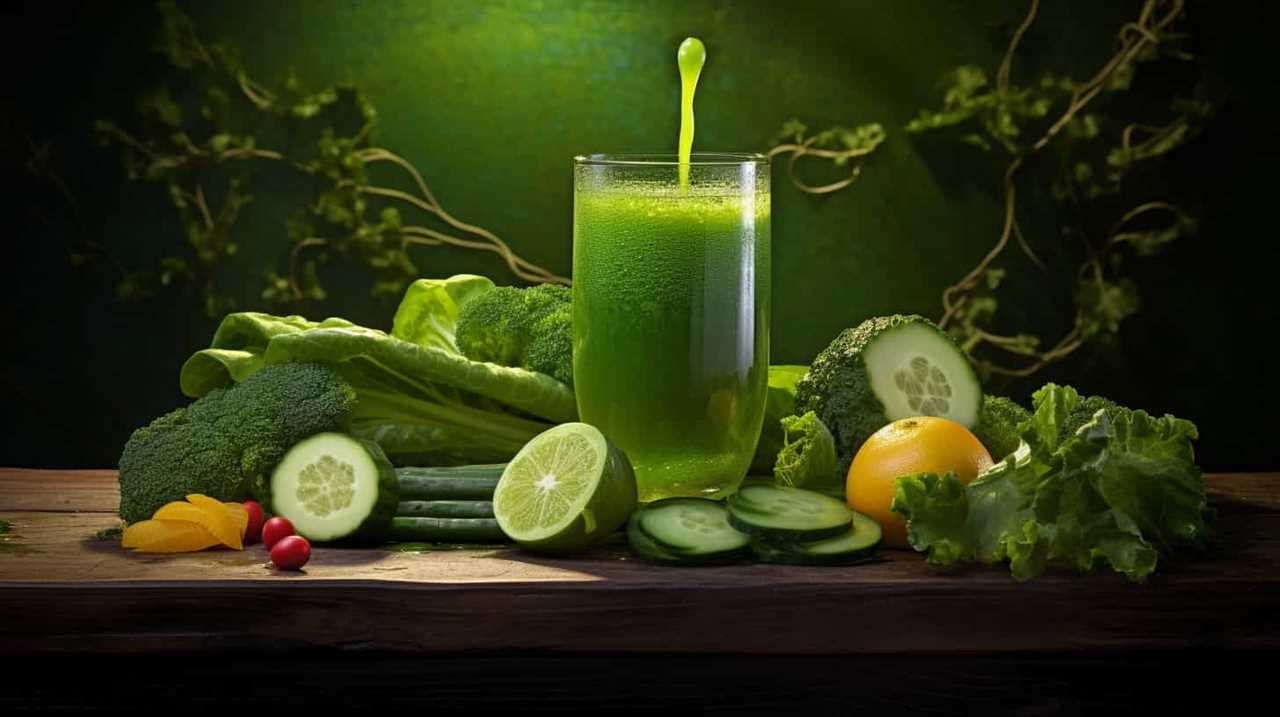
It’s important to start with the right pitcher. Look for a pitcher that’s made of glass or BPA-free plastic, as these materials won’t affect the taste of the lemonade. The pitcher should also have a lid or cover to keep the lemonade fresh and prevent spills.
Now, let’s talk about the lemons. While bottled lemon juice is convenient, using fresh lemons instead can elevate the flavor of your lemonade. Choose lemons that are firm and have a bright yellow color. Give them a gentle squeeze to ensure they’re juicy. To extract the juice, you’ll need a citrus juicer or a reamer. These tools make it easy to get every last drop of juice from the lemons.
Mixing the Lemonade Concentrate
To start mixing the lemonade concentrate, we’ll slowly pour the bottled lemon juice into the pitcher. It’s important to choose the right container for the lemonade concentrate. A pitcher with a lid or a tightly sealed container will help maintain the freshness and prevent any spills or leaks. Once the lemon juice is in the pitcher, we can move on to the next step of adding water and sweetener.
To ensure the lemonade concentrate stays fresh, it’s essential to store it properly. Keep the pitcher in the refrigerator to maintain its cool temperature and prevent any bacteria growth. If you have any leftover concentrate, transfer it to a smaller container with an airtight lid before refrigerating. This will help retain its flavor and prevent any contamination.

Now that we’ve mixed the lemonade concentrate, it’s time to adjust the sweetness and tartness to taste.
Adjusting the Sweetness and Tartness to Taste
We can adjust the sweetness and tartness of the lemonade to taste by adding more sugar or lemon juice, respectively. If you prefer a sweeter lemonade, simply add more sugar and stir until it dissolves completely. You can experiment with different sweeteners such as honey or agave syrup to find the perfect balance of sweetness.
On the other hand, if you want a tangier lemonade, add more lemon juice gradually, tasting as you go until it reaches your desired level of tartness.
Additionally, you can get creative with your lemonade by adding flavors like fresh mint leaves or a hint of lavender. These additions can elevate the flavor profile and create a more refreshing and unique experience.

Now that we’ve adjusted the sweetness and tartness of our lemonade, let’s move on to serving and enjoying your refreshing glass of lemonade.
Serving and Enjoying Your Refreshing Glass of Lemonade
Now let’s sit back, relax, and savor our refreshing glass of lemonade.
When it comes to serving and enjoying this delightful drink, there are a few techniques and garnishing options to consider.
Firstly, serving your lemonade chilled is essential for maximum enjoyment. Ensure that you have chilled glasses or add ice cubes to the glasses before pouring the lemonade.

To add a touch of elegance, you can garnish your lemonade with a slice of lemon on the rim of the glass. For an extra burst of flavor, you could also add a sprig of fresh mint or a few berries.
Remember to gently stir the lemonade before serving to evenly distribute the flavors.
Now, take a sip, feel the refreshing tang of lemon, and let the sweet and tart flavors dance on your taste buds.
Cheers!

Frequently Asked Questions
Can I Use Fresh Lemons Instead of Bottled Lemon Juice?
Fresh lemons offer numerous benefits over bottled lemon juice. The taste of fresh lemons is unparalleled, providing a vibrant and tangy flavor. Incorporating fresh lemons into your lemonade will elevate its taste and give it a refreshing and authentic twist.
Can I Substitute Sugar With a Different Sweetener?
Substituting sweeteners in lemonade can enhance the flavor and offer health benefits. We’re knowledgeable about alternative sweeteners and can provide precise, detailed instructions on using them in place of sugar.
How Long Does the Lemonade Concentrate Need to Chill in the Refrigerator?
The chilling time for the lemonade concentrate in the refrigerator is typically around 1-2 hours. Using bottled lemon juice offers the benefit of convenience and consistent flavor for a refreshing glass of lemonade.
Can I Add Other Fruits or Flavors to the Lemonade?
Sure, we can definitely add different fruits or flavors to our lemonade. It’s a great way to experiment with unique flavors and create refreshing, personalized drinks. The possibilities are endless!

How Long Does the Lemonade Stay Fresh in the Refrigerator?
Lemonade made with bottled lemon juice can stay fresh in the refrigerator for about 5-7 days. To maximize shelf life, store it in an airtight container and keep it chilled.
Conclusion
And so, with a few simple steps and the right ingredients, a glass of refreshing lemonade is born.
Like a symphony of flavors dancing on your taste buds, this tangy elixir quenches thirst and brings joy on a hot summer day.
Just a sip transports you to a world of citrusy delight, where the sweetness and tartness blend harmoniously.

So go ahead, indulge in the art of lemonade-making and savor every drop of this sun-kissed nectar.
Cheers to the perfect glass of lemonade!
Susannah expertise lies in researching and compiling evidence-based content on juicing, nutrition, and overall health. She is committed to ensuring that The Juicery World offers accurate, up-to-date, and trustworthy information to empower readers to take control of their health. Susannah’s goal is to inspire individuals to embrace juicing as a way to nourish their bodies and live their best lives.
Juice Tips and Tricks
How to Know if Orange Juice Is Bad

We’ve all been in that situation before – reaching for a glass of orange juice and hesitating, unsure if it’s still okay to drink. Fear not! This article will give you the knowledge you need to determine for sure if your orange juice is still fresh or if it’s gone bad.
With a blend of scientific precision and practical tips, we’ll explore color changes, strange smells, off taste, texture changes, and mold or growth that may indicate spoilage.
Let’s dive in and serve ourselves a refreshing glass of certainty!
Key Takeaways
- Color changes in orange juice can indicate a loss of freshness and shelf life extension, but it doesn’t necessarily mean the juice is bad.
- Unusual or off-putting odors in orange juice, such as sour or fermented scents, can be a sign of poor quality.
- An off taste in orange juice, such as sour, bitter, or fermented flavors, suggests that the juice is spoiled.
- Texture changes in orange juice, such as pulp separation or a thicker consistency, can occur as the juice ages, so it’s important to consume it before the expiration date.
Color Changes in Orange Juice
We should be aware that color changes can indicate whether orange juice is bad.

When it comes to orange juice, color is a crucial factor to consider. As oranges are exposed to air, an oxidation process occurs, which leads to changes in color. Fresh orange juice has a vibrant orange hue, indicating its freshness and high nutritional value.
However, as time passes, the juice may undergo a color change, turning dull or brownish. This change in color is a result of the oxidation process, which affects the flavor and quality of the juice. It’s important to note that while a change in color doesn’t necessarily mean the juice is bad, it does indicate that the juice is losing its freshness and shelf life extension.
Therefore, it’s advisable to consume orange juice when it’s at its freshest, as indicated by its vibrant orange color.
Strange Smells in Orange Juice
When it comes to evaluating orange juice, we should be cautious of any strange smells or odors. A fresh, pleasant smell is indicative of good quality orange juice. However, if you notice any unusual or off-putting odors, it may be a sign that the juice has gone bad. These smells can range from a sour or fermented scent to a rancid or moldy aroma.

It’s important to note that while some natural variations in scent can occur due to the specific variety of oranges used, any strong or unpleasant smells should raise concerns. If you have citrus fruit allergies, it’s especially important to pay attention to the smell of orange juice, as it could indicate the presence of spoilage or contamination.
Ensuring the quality of orange juice is essential as it’s a popular beverage known for its health benefits, including being rich in vitamin C and antioxidants.
Off Taste of Orange Juice
Our taste buds can detect even the slightest hint of an off taste in orange juice, which can indicate that it has gone bad. The taste of orange juice should be fresh, tangy, and slightly sweet. If it tastes sour, bitter, or fermented, it’s likely spoiled.
One common cause of an off taste in orange juice is the use of overripe oranges. When oranges become overripe, their flavor profile changes, resulting in a less pleasant taste. Another factor to consider is the expiration date. Orange juice that has passed its expiration date is more likely to develop an off taste. It’s important to check the expiration date before consuming orange juice to ensure its freshness and quality. Additionally, improper storage conditions, such as leaving the juice at room temperature for extended periods, can lead to the development of unpleasant flavors. Storing orange juice in the refrigerator helps maintain its freshness for longer. For those exploring different juice options, aloe vera juice flavor tips suggest pairing tart juices with milder flavors to balance the overall taste.
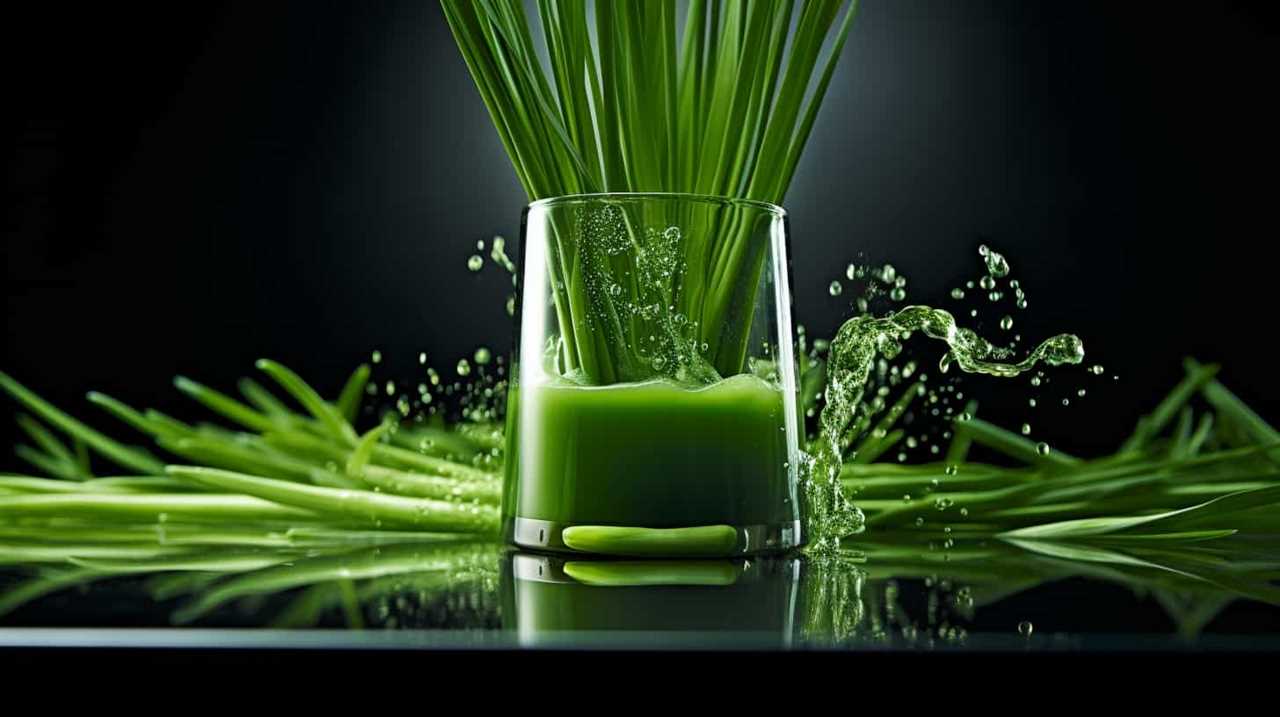
Now, let’s move on to discuss the texture changes in orange juice.
Texture Changes in Orange Juice
As we explore the texture changes in orange juice, it’s important to note that certain factors can cause it to become thicker or develop sediment. One common texture change in orange juice is pulp separation, where the pulp separates from the liquid and settles at the bottom. This can occur naturally over time, as the pulp particles become denser and sink.
Another factor that can affect the texture of orange juice is the expiration date. As orange juice ages, it may start to develop a thicker consistency and even form sediment. This is a result of the natural breakdown of the juice’s components. Therefore, it’s crucial to check the expiration date on orange juice and consume it before it reaches its expiration date to avoid any undesirable texture changes.
Mold or Growth in Orange Juice
We need to be aware of the possibility of mold or other growth occurring in orange juice. Mold can develop in orange juice if it isn’t stored properly or if it has passed its expiration date.

To prevent mold growth, it’s important to follow these steps:
- Store orange juice in the refrigerator at a temperature below 40°F (4°C).
- Check the expiration date on the bottle before consuming. Discard any orange juice that has expired.
- Keep the container tightly sealed to prevent air and moisture from entering, as these can promote mold growth.
Regularly inspecting orange juice for any signs of mold or unusual growth is essential. If you notice any discoloration, a strange odor, or visible mold, it’s best to discard the juice to avoid any potential health risks.
Frequently Asked Questions
Can Orange Juice Go Bad if It’s Stored in the Freezer for Too Long?
Frozen orange juice can potentially lose its nutrients and change its taste if stored in the freezer for too long. It is important to check for signs of spoilage before consuming it.
How Long Can Orange Juice Stay Fresh in the Refrigerator Once It’s Opened?
Once opened, orange juice can stay fresh in the refrigerator for about 7-10 days. To maintain its freshness, store it properly by keeping it tightly sealed and at a consistently cold temperature. If the orange juice develops an off odor, flavor, or appearance, it’s best to discard it to avoid any potential health risks. Factors like exposure to air and varying temperatures can influence how long orange juice lasts, so it’s crucial to handle it with care. Always check the expiration date as a general guide, but remember that proper storage can extend its freshness slightly. Additionally, avoid leaving the orange juice out at room temperature for extended periods, as this can significantly shorten how long orange juice lasts. Freezing the juice can be another option to extend its shelf life, but be aware that this may alter its texture and taste once thawed. By following these precautions, you can ensure your orange juice stays fresh and safe to consume.
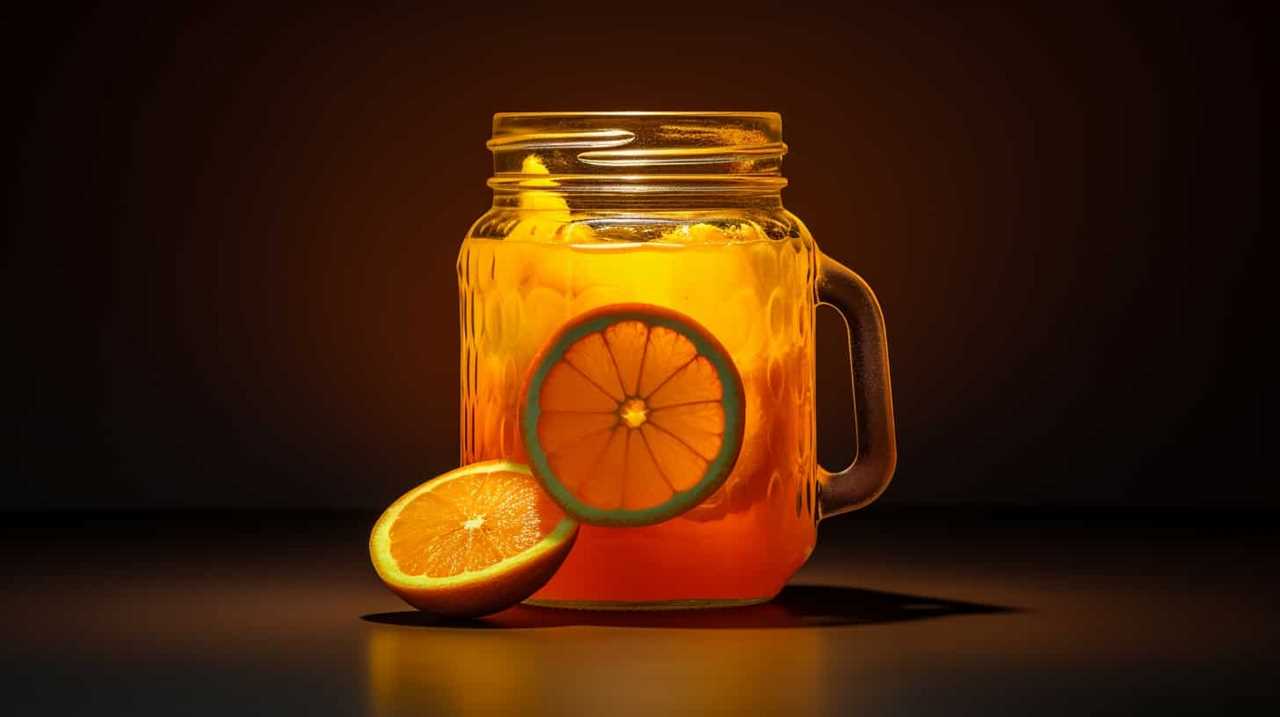
Is It Safe to Consume Orange Juice That Has Been Left Out at Room Temperature Overnight?
Left out orange juice may not be safe to drink as it can harbor harmful bacteria. Signs of spoiled orange juice include a sour smell, mold growth, and a change in color or taste.
Can Orange Juice Develop Harmful Bacteria if It’s Past Its Expiration Date but Still Looks and Smells Fine?
Orange juice can cause food poisoning if it develops harmful bacteria, even if it looks and smells fine. Signs of spoiled orange juice include a sour smell, mold growth, and a change in color or taste.
Does the Nutritional Value of Orange Juice Decrease as It Starts to Go Bad?
As orange juice goes bad, its nutritional value decreases. The longer it sits on the shelf, the more nutrients it loses. Signs of spoilage include a sour smell, off taste, and mold growth.
Conclusion
In conclusion, determining if orange juice is bad requires careful observation of color changes, strange smells, off taste, and texture changes. Just like a detective investigating a case, we must rely on our senses to detect any signs of spoilage.
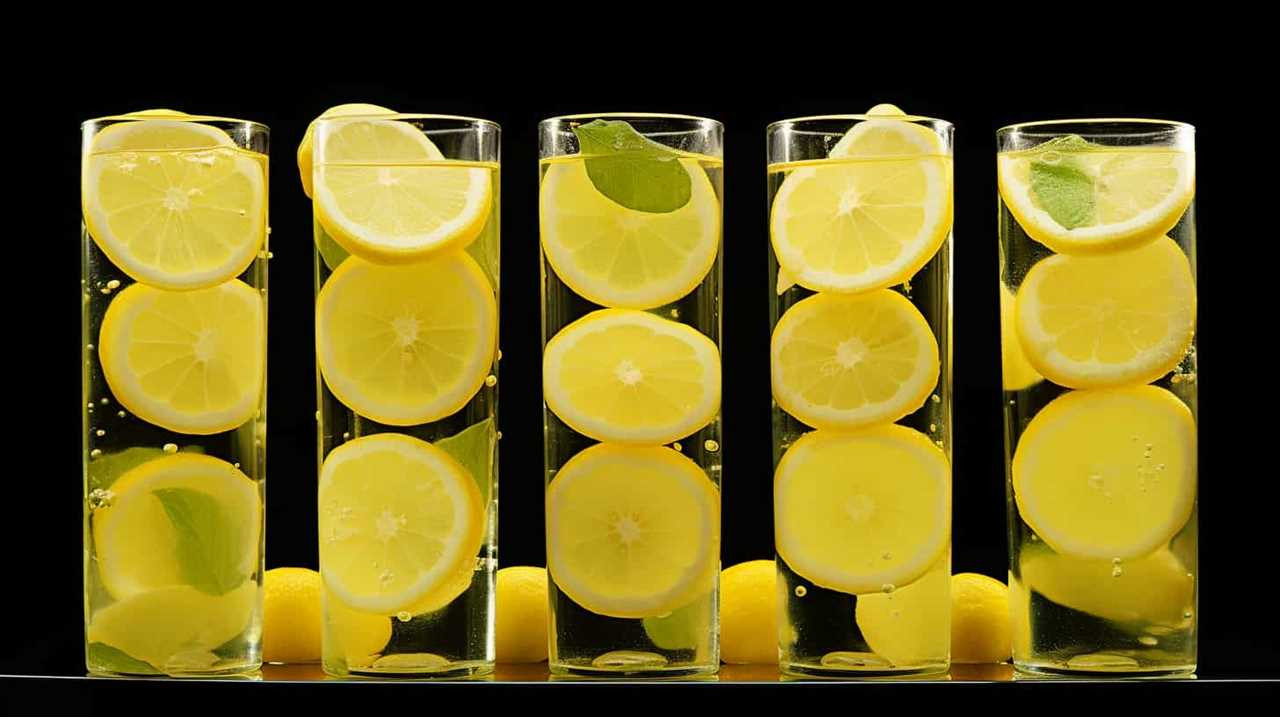
If we detect mold or growth in the orange juice, it’s a clear indication that it’s no longer safe to consume. By remaining vigilant and attuned to these indicators, we can ensure that our orange juice is always fresh and enjoyable.
Susannah expertise lies in researching and compiling evidence-based content on juicing, nutrition, and overall health. She is committed to ensuring that The Juicery World offers accurate, up-to-date, and trustworthy information to empower readers to take control of their health. Susannah’s goal is to inspire individuals to embrace juicing as a way to nourish their bodies and live their best lives.
-

 Vetted2 months ago
Vetted2 months ago15 Best Juices for Diabetics: Refreshing Options That Won’t Spike Your Blood Sugar
-

 Vetted2 months ago
Vetted2 months ago15 Best Decaf Coffee Options for Flavor Lovers Who Need a Caffeine Break
-

 Vetted2 months ago
Vetted2 months ago15 Best Espresso Ground Coffees to Elevate Your Morning Brew
-

 Vetted2 months ago
Vetted2 months ago15 Best K-Cup Coffee Pods for a Perfect Brew Every Time
-

 Vetted2 months ago
Vetted2 months ago15 Best Beans for Espresso: A Guide to Perfecting Your Brew
-

 Vetted2 months ago
Vetted2 months ago15 Best Inexpensive Espresso Machines That Brew Quality Coffee on a Budget
-

 Vetted2 months ago
Vetted2 months ago15 Best Kona Coffees to Savor the Rich Flavors of Hawaii
-

 Vetted2 months ago
Vetted2 months ago15 Best Cold Brew Coffees to Keep You Refreshed All Summer Long





